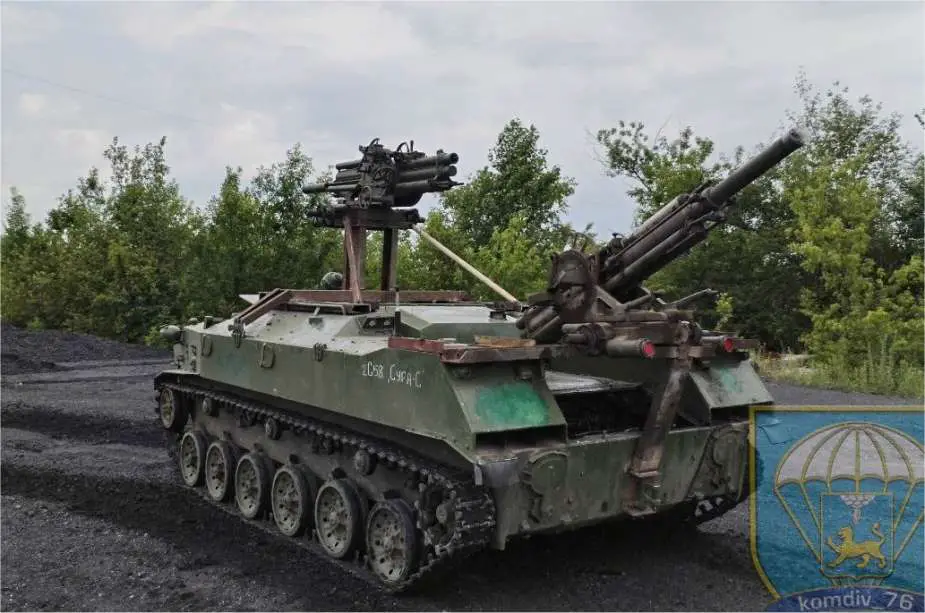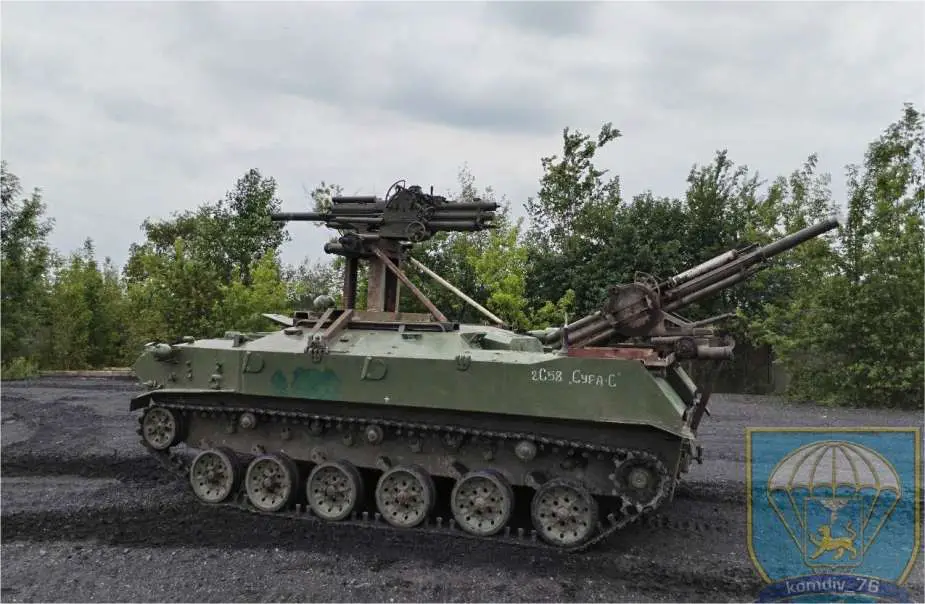On a VK ( Russian social media) post from Military Informant dated October 24, 2023, one can spot a BTR-D equipped with two 2B9 mortars. Russian ingenuity takes another unusual turn with this new vehicle, but what is the real interest in placing two mortars on a lightweight, air-transportable vehicle like the BTR-D?
Follow Army Recognition on Google News at this link

BTR-D 2S58 "Sura-S" of Russian paratroopers with two automatic smooth-bore mortars of 82 mm caliber 2B9M "Vasilyok" (Picture source: VK Account of Military Informant)
This enigmatic newcomer is a BTR-D, a nine-ton armored vehicle that can be airlifted and is traditionally used by airborne forces. Intriguingly, it is equipped not with one, but with two 2B9 automatic mortars, one at each end of the vehicle. Although the vehicle has not yet been deployed to the front lines of the ongoing conflict between Russia and Ukraine, such unique configurations usually end up being sent there as part of Russia's growing fleet of improvised combat vehicles.
The BTR-D is a Russian-designed armored vehicle that has a relatively light weight of 8,000 kg, allowing it to be air-transportable. Its dimensions are 5.88 meters in length, 2.63 meters in width, and 1.67 meters in height. While not heavily armored, the BTR-D offers sufficient protection against small arms fire and shell splinters, making it a suitable choice for the rapid deployment of troops and airborne forces. The vehicle is designed to accommodate a one-person crew, plus 13 additional troops, and has various accessories to enhance its utility on the battlefield, including night vision capabilities, an NBC (Nuclear, Biological, Chemical) protection system, and an infrared searchlight.
The BTR-D is versatile in its armament options, typically equipped with two 7.62 mm PKT machine guns. However, configurations can vary to include a heavier 12.7 mm machine gun or even a 30 mm automatic grenade launcher, offering a wide range of tactical possibilities. This adaptability in armament adds another layer to the BTR-D's flexibility on the battlefield. It can deliver a variety of munitions, depending on mission requirements, without needing a change of vehicle platform.
Operating at a maximum speed of 61 km/h and having an operational range of 500 km, the BTR-D can cover large distances relatively quickly. This is particularly useful in extended terrains and long-distance operations. Currently, the vehicle is not exclusive to Russia; it is also used by several other countries, including Azerbaijan, Belarus, Moldova, Ukraine, and Uzbekistan. The versatile nature of the BTR-D, as well as its widespread use, underscores its importance in modern military arsenals.
It is therefore easy to understand why a 2B9 mortar would be mounted on a BTR-D. The 2B9 can launch an 82mm projectile weighing around 3.18 kg up to a distance of 3.22 kilometers, offering a potent mix of firepower and mobility when mounted on the BTR-D. However, the logic behind installing two 2B9 mortars is less clear.
Operating a single 2B9 requires a crew of three people. The question then arises: can the compact BTR-D accommodate enough personnel to operate both mortars simultaneously? While it has a theoretical capacity of 13 passengers, one must not forget that to operate both mortars, ammunition must also be transported, and the BTR-D's very compact size compromises its ability to carry a large amount of ammunition. Moreover, can the vehicle effectively aim and fire both weapons in the same direction? Otherwise, must it position itself between enemy units to fully utilize both mortars? The already lightly armored BTR-D could be at greater risk if it receives incoming fire from multiple directions.
Russia has increasingly turned to unconventional solutions to compensate for its large vehicle losses in Ukraine, mounting a range of available armaments on various vehicle platforms. While these improvised configurations have generally improved over time, probably due to battlefield experience, this latest double-mortar BTR-D seems to go against the trend toward more practical designs.
Previously, Russian engineers had mounted a 2B9 and a UB32 rocket pod on an MT-LB armored vehicle, only to quickly discover the impracticality of using both weapons at the same time—the rocket exhaust gases would endanger the mortar crew. Lessons appeared to have been learned, as subsequent iterations omitted the 2B9. This latest double-mortar BTR-D seems to veer off the path toward more effective DIY military vehicles. While its design is certainly eye-catching, its utility and effectiveness on the battlefield remain questionable.
 BTR-D of Russian paratroopers with two automatic mortars 2B9 (Picture source: VK Account of Military Informant)
BTR-D of Russian paratroopers with two automatic mortars 2B9 (Picture source: VK Account of Military Informant)















